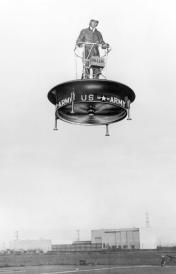Jet engine technologies for interested amateurs
Last Updated: 14 June, 2002
|
The Objective The freedom of jet-powered personal flight using a small, lightweight jet-powered backpack or craft has long been the dream of many young (and not so young) boys. Having developed successful working prototypes of the X-Jet engine to the point where they are a powerful, reliable source of thrust, I began to consider how I might demonstrate the capabilities of these engines in some practical manner. I often get email from people who say they'd love to have a "jet pack" that they could strap to their back and fly just like in the movies -- but unfortunately this is not particularly practical. Even the jetpacks sometimes seen in movies and on TV are actually powered not by a jet engine but by a hydrogen peroxide rocket motor. A jet-powered backpack would be simply too heavy and cumbersome -- early prototypes built in the 1970's by Bell and licensed to Williams were so heavy that the pilot's legs ended up having to support over 360 pounds of weight when the engine was stopped. Just imagine the effect of a slightly heavy landing! What's more, the engine alone cost nearly $100,000 (which was a lot fo money back then).
Other Flying Platforms The flying platform idea is not dead however. An Israeli company is producing kitsets for a craft called the Hummingbird which is very similar to the HFP, although I've not seen much evidence of commercial success yet.
My Version Let me make it quite clear that a pulsejet is not the ideal means of powering a flying platform -- the effective conversion of thrust to horsepower at low speeds with a pulsejet is abysmal. What's needed to create a hovering/flying platform is a wide column of fairly slow moving air -- pulsejets create a very narrow column of extremely fast-moving air. You can think of this as being like a car stuck in top gear -- very efficient when you're moving fast but not at all good for moving at low speeds or pulling away from a standing start. Fortunately there is a device that effectively "gears down" a pulsejet by converting that narrow column of high-speed gas into a wider, slower column of gas -- it's called an augmentor. What I intend to do with my flying platform is to use three X-Jet engines coupled into a common central duct which also acts as an annular wing, similar to (but much narrower than) that used by the HFP. The augmentor will do several things:
The exact layout of the X-Jet flying platform hasn't yet been decided and I'm still mulling over a number of options. A lack of funding for the R&D of X-Jet engine itself has meant that the flying platform project will remain on the back-burner for the time being. However, bookmark this page and stay tuned for updates!
|
|

 However, one vehicle that I've always been fascinated by is the
However, one vehicle that I've always been fascinated by is the